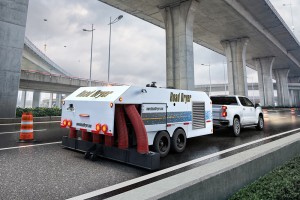Drying repaved road surfaces quickly
First published in CONEXPO-CON/AGG Preview News - March 6, 2020
 Road Dryer says that its units can help allow traffic back onto recently surfaced roads more quickly than before
Road Dryer says that its units can help allow traffic back onto recently surfaced roads more quickly than beforeSouth Carolina-based Road Dryer says that its truck- or trailer-mounted Road Dryer RD-1200XT can speed drying of asphalt and concrete pavement. The firm says that this allows crews to pave or apply surface treatments or striping after just one pass. The unit, which blows heated air up to 204°C directly downward through multiple nozzles, eliminates the risk of flying objects, and allows traffic to flow in nearby lanes. The Road Dryer unit can be adjusted for drying widths 2.4-3.7m. Because it dries pavement on demand, it provides flexibility for contractors and government agencies to meet timetables by minimising delays from weather- and project-related wet conditions.
The Road Dryer unit provides safety benefits not possible with most widely used pavement drying methods. Traditional attempts at drying pavement for construction or maintenance work have typically involved the use of jet engine dryers, infrared heat, or portable blowers, combined with brooms and manual squeegees. Each of these methods has its own limitations and safety concerns, including the use of jet fuel, noise, melting pavement, danger from thrown rocks or other objects, and slow results. Because of this, traffic is often fully restricted from travelling on roads or runways where drying work is taking place. The Road Dryer eliminates all of these issues, as it swiftly and safely dries the pavement. The RD-1200XT preconditions the incoming air to remove moisture prior to heating and directing the heated air to the road, allowing faster drying time. The unit will not harm asphalt, as the flow of drying air does not exceed 204°C.
Weather is not the only cause of wet pavement. Milling processes also use water to cool grinder teeth, leaving the road surface wet and unsuitable for paving until dry. The Road Dryer can follow behind a milling machine and immediately dry the pavement for resurfacing. Because the pavement is typically ready for paving or surfacing within an hour, it allows for increased throughput by several road miles per shift. For striping operations, hydro-blasting leaves the road surface wet, and it must be dried before new paint may be sprayed. With a Road Dryer RD-1200 following the hydro-blaster to dry the surface, a paint sprayer may be run immediately behind the Road Dryer unit, to paint or repaint lines.
Companies in this article
Road Dryer
Most popular news
- Software collaboration tool from Bentley
March 13, 2020 - VSS Macropaver adds telematics to its complete line-up of machines
March 13, 2020 - LiuGong unveils new mini excavator trio
March 13, 2020 - Kleemann showcases mobile crushers and screeners
March 13, 2020 - Brokk unveils Atomized Water Mist system for silica dust suppression
March 13, 2020 - OilQuick and Engcon join forces on new tiltrotator
March 13, 2020











